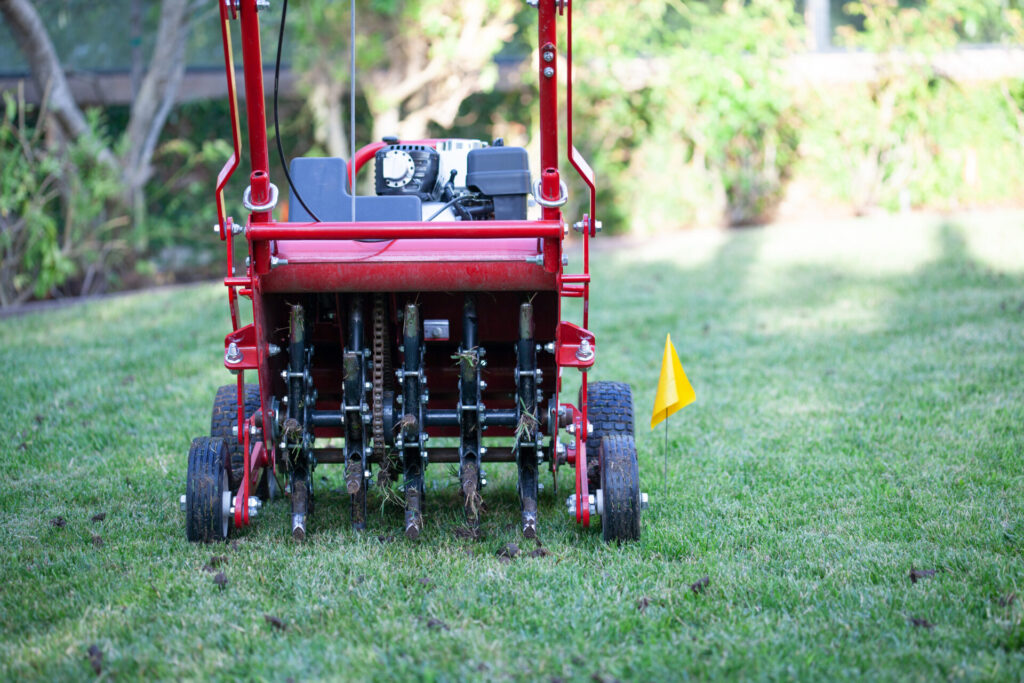A healthy, vibrant lawn enhances the overall appeal of your home and provides a welcoming outdoor space for relaxation and recreation. However, achieving and maintaining its lush appearance requires more than routine mowing and watering. Advanced techniques like lawn aeration and overseeding are essential to address specific health issues and enhance overall quality. These practices ensure your lawn remains robust and beautiful throughout the seasons.
This blog will explore the specific benefits of lawn aeration and overseeding and examine various factors for determining the best times to implement these techniques.
What Is Lawn Aeration?
Lawn aeration is the process of creating small holes in the soil to allow air, water, and nutrients to penetrate the root zone more effectively. Here’s how it benefits your lawn:
- Reduces soil compaction: Over time, foot traffic, lawn equipment, and natural settling can lead to soil compaction. This makes it difficult for roots to grow and absorb essential nutrients. Aeration loosens the soil, allowing roots to expand freely and access necessary resources to promote lawn health.
- Improves nutrient absorption: Aeration breaks up compacted soil, allowing better penetration of fertilizers and amendments. This ensures your lawn gets the full benefits, leading to healthier, more vigorous growth.
- Enhances water infiltration: Compaction can cause water to run off rather than soak into the soil. Aeration improves water infiltration, reducing runoff and ensuring consistent moisture supply to your lawn. This is particularly beneficial during dry periods, helping to maintain optimal hydration.
- Encourages thicker grass growth: By improving soil conditions and root health, aeration stimulates the development of new grass shoots. This leads to a denser, more resilient lawn that can better compete with weeds and resist erosion.
What Is Overseeding?
Overseeding is the process of spreading grass seed over an existing lawn to introduce new varieties or improve the density of the current turf. Here are some of its advantages:
- Improves lawn density: Overseeding helps to fill in bare patches and thicken thin areas of your lawn. This results in a more uniform and attractive appearance, making your lawn look healthier and more vibrant.
- Enhances disease resistance: Introducing new grass varieties can increase your lawn’s overall resistance to diseases and pests. This diversity can help ensure that your lawn remains resilient under various conditions.
- Improves drought tolerance: Certain grass species are more drought-resistant than others. Overseeding with these varieties can enhance your lawn’s ability to withstand dry conditions, reducing the need for frequent watering.
- Promotes a greener lawn: New grass varieties introduced through overseeding can offer improved color and texture. This can enhance the overall aesthetic of your lawn, giving it a richer green hue.
How Aeration and Overseeding Work Together
Combining aeration and overseeding offers the best results for your lawn. Aeration creates an ideal environment for seed germination by improving seed-to-soil contact. The holes created during aeration provide spaces for seeds to settle and make contact with the soil, increasing the chances of successful germination and growth. The combined benefits of lawn aeration and overseeding lead to a healthier, more resilient turf with enhanced growth and appearance.
When To Aerate and Overseed
The timing for aeration and overseeding depends on several factors:
- Grass type: Cool-season grasses like Kentucky bluegrass and fescue should be aerated and overseeded in early fall. Meanwhile, warm-season grasses like Bermuda and zoysia are best treated in late spring to early summer.
- Soil conditions: Ensure the soil is neither too dry nor overly saturated. Aeration should be done when the soil is moist but not soggy to allow for effective penetration and seed-to-soil contact.
- Lawn health: Aerate and overseed lawns that have compacted soil, thin spots, or heavy thatch. Assess the overall health of your lawn to determine if it would benefit from these practices.
- Weather conditions: Perform these practices when weather conditions are conducive to grass growth. Avoid aerating and overseeding during extreme temperatures or when heavy rainfall is expected.
Experience the Benefits of Lawn Aeration and Overseeding With Well Rooted Gardens
Since 2007, Well Rooted Gardens has been the go-to expert for all your lawn care needs! Our team is well-versed in the best practices for aeration and overseeding, ensuring that your lawn receives the expert care it deserves. We also offer a full range of turf care services, including mowing and weed control, to keep your lawn in top shape.
Contact us today or call 402-800-7389 to schedule your consultation and experience the difference that expert care can make!

